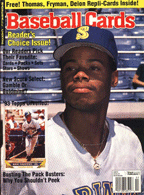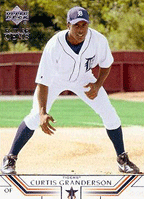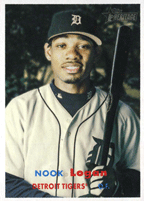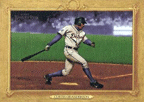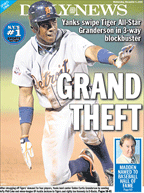| Curtis Granderson — Biography | |||||
| bio | facts | what they say | my say | ||
20-20. 30-30. 40-40. Baseball's hitting evolution used to follow a nice, straight line. With the emergence of Curtis Granderson, however, who knows where the sport is headed? The fourth 20-20-20-20 man in big-league history, Curtis is redefining the parameters of speed and power. Doubles, triples, home runs and steals—the new center fielder in the Bronx collects them like a kid playing on a sandlot. And this from a guy who dreamed of being an NBA star! This is his story…
| |
GROWING UP
Curtis Granderson was born on March 16, 1981 in Blue Island, Illinois. (Click here for a complete listing of today's sports birthdays.) His parents, Curtis Sr. and Mary, were both educators and impressed upon him the importance of staying in school. Curtis Sr. worked as a gym teacher at Nathan Hale Elementary, and Mary taught science at Curie High School.
The Grandersons lived in Lynwood, a southern suburb of Chicago. A gifted student, Curtis heeded the advice of his parents and spent plenty of time hitting the books. Intelligent and articulate, he felt right at home in the classroom.
But Curtis was also a great athlete. His two favorite sports were basketball and baseball. He credits his friends for getting him on the diamond. Watching his father play 16” softball was also a catalyst.
Curtis began his baseball career as a shortstop in his local Little League. A right-handed thrower, he found the swinging motion—whether it was a baseball bat or a hockey stick—more comfortable from the left side. (His parents have pictures of him swinging as a lefty from as young as two-years-old.) He hit his first home run after his 10th birthday.
His parents were there to catch every one of their son's highlights. Mary never seemed to miss a game, and Curtis Sr. coached a couple of his boy's Little League teams.
With Chicago close by, Curtis rooted for the Cubs and White Sox. When he discovered WTBS, he began following the Atlanta Braves, especially after they rose to prominence in the National League. The player Curtis most identified with, however, was Ken Griffey Jr. He marveled at Junior's combination of speed and power at the plate and loved the way he roamed the outfield.
While Curtis Sr. and Mary encouraged Curtis in his athletic career, they made sure he was a well-rounded individual. When Curtis was old enough, he was expected to find a job. His first was as a 14-year-old with the Public Works Department, cleaning up the parks in the area he lived. Later, he served as a camp counselor and ran basketball tournaments.
Despite his obvious talent in baseball, Curtis dreamed of playing in the NBA. He starred in both sports at Thorton Fractions South High School. Because of Curtis's passion for hoops, some baseball scouts wrote him off as a serious prospect. Curtis, however, dominated in baseball throughout his high school career. In his junior year, he batted .326 with eight doubles and 22 RBIs. He was even better his senior year, hitting .427 with seven doubles, six home runs, and 47 RBIs. Curtis was selected SICA Central All-Conference and earned All-Area recognition from Illinois Times, Star Newspaper, and Daily Southtown.
After high school, Curtis settled on the University of Illinois-Chicago, where he majored in business management and business marketing. Hoops remained his top sports interest. In fact, he picked UIC over Illinois State and Northern Illinois in part because the Flames allowed him to walk on for the basketball team.
Curtis also played baseball at UIC. He had a great year as a freshman in the spring of 2000, leading the Flames with seven home runs and 45 walks. It was after this stellar campaign that Curtis finally started to recognize that he had big-league potential.
ON THE RISE
Curtis was a standout throughout his college career. In his sophomore year, he batted .304 with eight home runs. The following year, he hit .483 (second among all NCAA Division I players to Rickie Weeks) with nine homers, 45 RBIs, and 17 stolen bases. Curtis established UIC single-season records in batting average, runs and hits.
For his efforts, Curtis was voted the Horizon League Player of the Year, while Baseball America and USA Today’s Baseball Weekly named him a Second-Team All-American, He was also recognized as a Louisville Slugger NCAA Division I All-American.
Curtis intended to stay at UIC for four years. But as he heated up on the diamond, so did his prospects for the amateur draft. Both the Detroit Tigers and Cleveland Indians sent scouts to talk to him. Projected to go in the first five rounds, Curtis still decided to hedge his bets. Before the draft, he signed up for his senior classes.
![]()
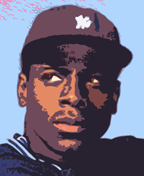
Curtis was a no-show that fall after Detroit took him in the third round with the 80th pick overall. The Tigers offered a $469,000 signing bonus, more than enough to persuade him to conclude his college career. (Still intent on earning his bachelor’s degree, Curtis would go back to UIC to continue his education. He finally earned his bachelor’s degree in the fall of 2003.)
The buzz on Curtis was created mostly by Baseball America, which named him to its College Draft All-Star squad and rated him as fifth-best pure hitter among amateurs. Jerome Cochran, the Detroit scout who signed Curtis, was equally enthusiastic about the young prospect.
Curtis began his professional career in the summer of 2002 with the Oneonta Tigers. There he hit .344 in 52 games and was voted the New York-Penn League's Most Valuable Player.
In 2003, Curtis was promoted to the Lakeland Tigers of the Florida State League. He enjoyed another strong season, flashing both his speed and power. In the FSL's spacious ballparks, Curtis legged out 29 doubles and 10 triples. He also his 11 home runs.
The 2004 season saw Curtis take another big step in his development. In a full year with the Erie Seawolves, he had a breakthrough campaign, hitting .303 with 21 homers and 93 RBIs. Curtis was named to the Eastern League’s post-season All-Star team and made Baseball America’s Double-A All-Star team. He also earned recognition as Detroit's Minor League Player of the Year.
The news wasn’t nearly as good with the big club, as Detroit struggled to its worst season ever. After a 43-119 campaign, fans hoped that the farm system would help resurrect the failing Tigers. Under the careful watch of new GM Dave Dombrowski, that was about to happen.
Tigers fans got a glimpse of the team's future on September 13 when Curtis made his big-league debut against Minnesota in Comerica Park. Before the game, Twins outfielders Torii Hunter, Jacque Jones, and Shannon Stewart introduced themselves and wished Curtis well. Hunter even took some time to share hitting advice. The two eventually built a close friendship.
That fall, Curtis played for Grand Canyon in the Arizona Fall League. In 23 games for the Rafters, he batted .321 with 16 runs, four doubles, a home run, and 15 RBIs. Curtis was later honored as one of six nominees for the MLB.com AFL Dernell Stenson Sportsmanship Award.
Despite his steady improvement, Curtis began 2005 in the minors with the Toledo Mud Hens. The Tigers wanted to see how he fared against Triple-A pitching. Curtis responded with terrific numbers through the season's opening months. By mid-summer, he was hitting .290 with 15 home runs, 65 RBIs, and 22 stolen bases.
On July 22, the Tigers recalled Curtis from Toledo. A day later, he hit his first big-league homer, off of Minnesota’s Carlos Silva. Curtis stung the ball for a solid week, hitting .318 with two triples, two home runs, and four RBIs. But the Tigers still weren't ready to commit to him. The team already had a center fielder in Nook Logan and believed he was their leadoff man of the future. Curtis returned to Toledo before the calendar turned to August.
Several weeks later, Curtis was called back to the majors. He remained there for the rest of the season, coming off the bench as a pinch-hitter, pinch-runner and defensive replacement. In his limited time, Curtis made quite an impression. He thrilled fans with an inside-the-park home run on September 15, posted a five-hit game on September 18, and launched a walk-off homer on September 26.
Curtis spent the offseason working on his game in the Dominican Winter League. To increase his chances of sticking with the Tigers, he volunteered to play right field. While Curtis struggled against the veteran pitchers of the DWL, he returned to the States a more confident player.
MAKING HIS MARK
Recognizing the improvements made by Curtis, the Tigers installed him as their starting center fielder for the 2006 season. Logan was the odd man out and was sent to the minors.
Curtis was the very definition of a hit-or-miss player during his first full year in the majors. He led the league with 174 strikeouts, the third highest single-season strikeout total in club history. When Curtis made contact, however, he proved a dangerous offensive weapon. In just under 600 at-bats, he collected 31 doubles, nine triples and 19 homers. A streaky hitter, Curtis had four four-hit games.
One of the highlights of his season was a homer and a triple in the first inning of a September game against the Kansas City Royals. In turn, Curtis became just the fifth major leaguer since 1987 to accomplish this feat, joining Tony Phillips, Steve Finley, Brandon Inge and Carl Crawford.
Curtis also flashed plenty of leather, using his speed to cover lots of ground in Comerica Park's cavernous outfield. He topped all AL outfielders with a .997 fielding percentage and finished second in the league with 389 total chances and 385 putouts.
Improved defense was one of the keys for the resurgent Tigers, who climbed in the AL Central standings and won the Wild Card. They faced the Yankees in the ALDS and pounded New York pitching when the series moved to Detroit. The Tigers won in four games. Curtis contributed two long balls.
It was on to meet the Oakland A’s in the ALCS. Riding the momentum from their first postseason victory in more than 20 years, the Tigers dominated the AL West champs in a four-game sweep. Curtis had a nice series, batting .333 with two doubles and a homer.
Detroit squared off against the St. Louis Cardinals in the World Series, a rematch of the 1968 Fall Classic. After St. Louis won Game 1, veteran Kenny Rogers threw a gem for the Tigers to even things up. Unfortunately, that was the lone highlight for Detroit. Awful defense plagued the team the rest of the way, and the Cards took the championship in five games.
Despite the disappointment of the World Series, the Tigers entered the 2007 campaign full of expectations. The roster remained largely unchanged, with Magglio Ordondez and Ivan Rodriguez anchoring the everyday lineup. The biggest addition was free-agent Gary Sheffield, who gave Detroit another dangerous bat in the middle of the batting order.
The Tigers also counted on Curtis to provide an offensive bump, though the team wondered whether youngster Cameron Maybin might be ready for the big leagues. Curtis chose to make the best of situation and took Maybin under his wing in spring training. The two became fast friends.
| |
As it turned out, Curtis had no reason to fear losing his job. From the season's opening month, he played like an All-Star. Curtis cut down his strikeouts, increased his power and used his speed much more effectively. Detroit manager Jim Leyland used him up and down the lineup, and Curtis responded with a year for the ages.
In early September, he became the fourth player in baseball history to join the 20-20-20-20 club. Curtis finished with 38 doubles, 23 triples, 23 home runs and 26 steals. Even though the Tigers faded down the stretch and missed the playoffs, he was mentioned on several MVP ballots.
Curtis took important strides off the field in 2007, as well. He became involved with the MLB Players Association and donated time to Volunteers of America’s Detroit Action Team to help raise literacy rates. Curtis earned public praise for his good works and was nominated for baseball's Roberto Clemente Award.
A broken finger suffered in spring training delayed the start of Curtis’s 2008 campaign. The Tigers missed his presence atop the lineup, opening the year at 0–7. Upon his return, Detroit clawed its way back to .500, but it took half the year to do so. Once there, the Tigers couldn't hold it together, finishing in fifth place with a 74–88 record.
Curtis had another good year nonetheless. He led the Tigers with 112 runs and a dozen steals. He put the ball in play more often and batted .280. He also hit 22 homers and led the AL again with 13 triples.
Detroit bounced back in 2009, leading the AL Central until the final weeks of the season. But the Tigers fell apart, and the Twins slipped in front of them for the division crown. Curtis seemed to take a step backward. His average plummeted to .249, and while his power numbers improved, the net effect was not a positive one. His 141 strikeouts—the same number that he had two years earlier—also was a point of concern.
Still, Curtis was selected to play in the 2009 All-Star Game, the first of his career. Anyone wondering how, or why, was instantly reminded when he replaced Josh Hamilton in the sixth inning of a 3–3 contest and drilled a one-out triple off Heath Bell. He scored the game-winning run on a sac fly by Adam Jones.
Heading into baseball’s winter meetings, the Tigers knew they had to shed some salary and trade some surplus. They made Curtis available, and the Yankees quickly snapped him up. There weren't many areas where the reigning champs could upgrade, but center field was one of them. Melky Cabrera and Brent Gardner did a good job in 2009, but neither was considered an impact player. Curtis is, of course. New York relinquished three good prospects in a three-way deal with the Tigers and Diamondbacks—minor leaguer Austin Jackson and pitchers Ian Kennedy and Phil Coke.
At 28, Curtis can still be counted among baseball's rising stars. His combination of speed and power remind some of legends like Willie Mays and Dave Winfield. While he's not there yet, Curtis has the potential to become a true star—especially if he learns to take aim at Yankee Stadium’s friendly right field wall. Perhaps the most refreshing thing about Curtis is his attitude. He is smart and articulate. He also plays the game the right way—something that New York fans have come to expect from their stars.
CURTIS THE PLAYER
Curtis is the perfect example of a modern-day player. He is an exceptional athlete with a few shortcomings that he is trying to fix. During his short time in the majors, he has brought down his strikeout total while raising his batting average and slugging percentage.
Curtis's biggest weakness is hitting against left-handed pitchers. He doesn't always pick up the ball well out of the pitcher's hand and ends up chasing a lot of offerings out of the strike zone. Given his speed and his increasing ability to make contact, Curtis has the tools to hold his own against southpaws.
Defensively, Curtis uses his speed to his advantage to run down balls in the gaps. He has also learned to position himself better and read hits off the bat. Runners once challenged his arm, but that doesn't happen much anymore.
Curtis has built his game on speed and athleticism. But don't sell him short. He's intelligent and hardworking. Curtis will always put in the effort to improve.
| Curtis Granderson — Biography | |||||
| bio | facts | what they say | my say | ||
© Copyright 2009 Black Book Partners, LLC. All rights reserved.
